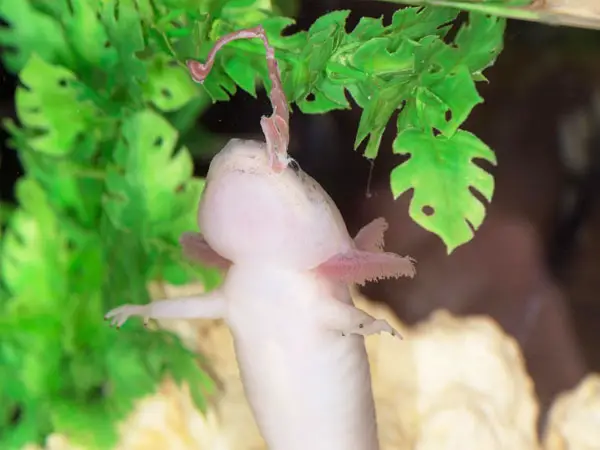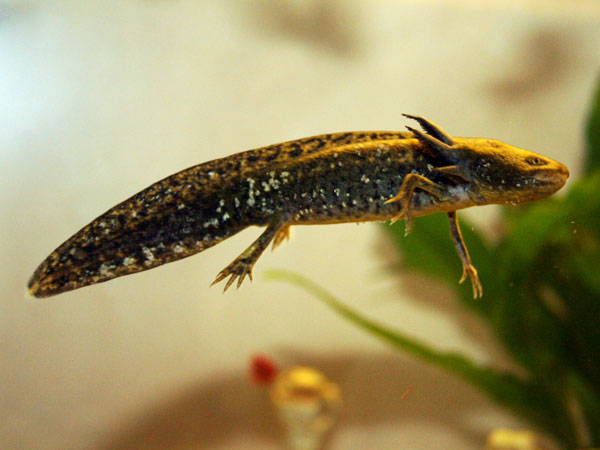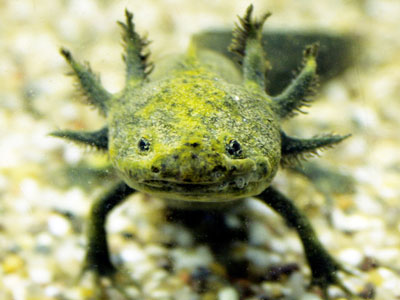If you are experiencing your axolotl vomiting, and you don’t know what to do to stop it, you’ve come to the right place. Here, we’ll take a look at whether axolotls vomit and why this behavior happens. We’ll also analyze how you can stop it from happening.

Yes, axolotls do vomit, and it’s mainly due to a few reasons. Some of the problems that cause vomiting are less serious than others, but mostly, they are solvable. That’s good to know, although some might require the help of a veterinarian or a professional in this field.
The most common problems that cause vomiting include:
- Ammonia poisoning
- Poor food quality
- Impaction
- Wrong water temperatures
- Too much food.
You’ll need to find the problem first and work your way towards solving it. Only this way the vomiting will stop, and it doesn’t hurt to know what you can do in the future to stop it.
Let’s take a look at each problem individually and see how you can solve it.
Ammonia Poisoning
Ammonia poisoning in axolotls will manifest itself in a few different ways. There will be symptoms for it, some more severe while some will not be as serious. Mostly, you’ll notice more symptoms occurring at the same time.
Vomiting is one of them, but you should inspect to find other symptoms, such as refusing to eat, gills falling off, general illness or sickness, apathy, and unusual behavior such as hiding.
Then, once you notice some of these reasons, you’ll want to inspect whether it is really the ammonia that’s causing the problem here. You can test for ammonia levels in the water with a drop test, or you can get a test kit which is usually more reliable than a drop test.
If you notice high levels of nitrates, then most likely, the ammonia levels are also too high. Ammonia is impossible to see with a naked eye, so a test is required. If you notice high ammonia levels, you need to act fast.
Make the water change as quickly as possible (50%), and do it on a daily basis, if not twice a day. Also, get a filter with biological and chemical filters if you haven’t got one already.
Poor Food Quality
Yes, if you feed your axolotl the wrong foods, then they might start to refuse it or vomit it out. Just like some of us don’t like various foods, axolotls will not like the foods of poor quality.
Some owners even try to feed them cat food, which is a bad idea. First, the food is bad for the axie, and it’s also bad for the water quality.
Take a look at what you’ve been feeding the axolotl lately. If the foods you’ve been feeding are of a poor standard and from unknown providers, then most likely, that’s the issue. The problem also occurs if the diet isn’t varied enough.
Try to keep a variety in their diet. Incorporate live foods, frozen foods, and pellets if you need to. Also, consider some supplements to improve the general health of the axolotl.
Impaction
Impaction is a common problem for axolotls. It happens when the axie eats a piece of gravel which then gets stuck in the gut of the axolotl, and can’t get out of the animal’s body.
That’s a reason for concern, and you’ll usually notice other symptoms to go with vomiting, such as bloating, refusal to eat, and even floating in the water.
You’ll want to contact your vet as soon as possible. This issue is difficult to solve; some people suggest fridging the axolotl, but that’s probably not the best of ideas. You can try it, but not for too long to not cause the stress on the animal.
Your best bet is to contact your vet and ask him for instructions. Only he can tell you exactly what to do with certainty.
Water Temperatures
Speaking of water temperature, it might be the reason for your axolotl vomiting. When the water is too cold, the axolotl will generally endure a lot of stress, and they will likely refuse all food you offer them. Also, it might start to vomit, which is a sign that the temperature is too low.
Increasing the temperature is thus your course of action. It’s a rare issue as the temperature problems are normally on the other side of the spectrum (too hot), but it happens, especially in the winter.
In this case, you’ll need a heater, or place the tank somewhere warm enough for the axolotl.
Remember, the ideal temperature for an axolotl tank is between 16-18 degrees Celsius (60-64 degrees Fahrenheit).
Too Much Food
This is perhaps the most common problem causing the axolotls to puke. Owners are not aware that axolotls will only require feeding twice a week or in some cases, maybe more often.
That’s why they feed them every day or even more often, and that can lead to several problems.
Obesity is one of them, and if there’s too much food to digest, vomiting. Axies will consume just about everything that comes their way, and sometimes, it can get too much.
Keep your eye on how much food you feed them. Also, you must not feed them too much at once, as they will vomit the excess food you give them.
The diet is perhaps the most important factor in axolotl’s health. You’ll need to be strict and not overfeed it, or else you’ll encounter problems like vomiting.
Conclusion
Axolotls vomiting can occur quite often, and it’s due to many reasons. First, you’ll need to know what the reason for vomiting is, and then you’ll have to work your way to solve the problem.
In some cases, the solution is simple, especially when it comes to the diet. For other problems, it’s a complex issue; impaction can be hard to solve, and ammonia is also hard to remove.
It’s best to take preventative measure to avoid having this issue at all.




